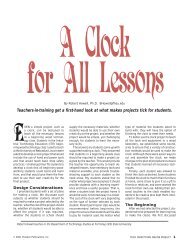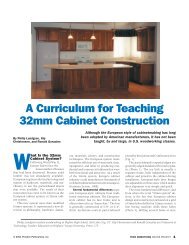Free Information - Tech Directions
Free Information - Tech Directions
Free Information - Tech Directions
- No tags were found...
Create successful ePaper yourself
Turn your PDF publications into a flip-book with our unique Google optimized e-Paper software.
direct from washingtonNew CTE ReportDespite fears about career andtechnical education (CTE) beingsqueezed out of the high school curriculum,overall student participationdid not change measurably between1990 and 2005. What changes thathave occurred probably dealt morewith the quality and focus than withenrollment, areas not covered in anew statistical report on vocationaleducation from the National Centerfor Education Statistics (NCES).In New York City, for example,Mayor Michael Bloomberg has announcedthat the city may open upto four new career schools, presumablyto make an end run around traditionalvocational schools that havea poor academic record. The mayorsaid earlier this year that “college isnot for everyone, but education is,”and his takeover of the city’s publicschool system has jolted business asusual in the nation’s largest schoolsystem, putting much more emphasison accountability for studentprogress. The city has 21 vocationalschools, but almost half (47 percent)are ranked C or less on student progressreports. Many of the newly createdsmall schools in New York Cityhave a career focus, and altogetherthe district offers more than 280vocational programs in regular orseparate schools.The NCES report gives a nationalpicture of the CTE status. About 88percent of public high schools offeredoccupational programs, withhalf of them having access to anarea CTE school for courses. In the15-year period studied, the averagenumber of total CTE creditsand occupational credits earned bypublic high school graduates didnot change. They totaled about fourcredits for CTE and three credits foroccupational courses. In contrast,the number of credential-seekingundergraduates majoring in careerfields increased by about one-halfwww.techdirections.comAnne C. Lewisanneclewis@earthlink.netmillion students, although theirproportion of the overall enrollmentdecreased.For the rest of this item, visitwww.techdirections.com/w091.html.Plans for Educationfrom Politicians and OthersThe link between education andthe economy barely goes past rhetoricin the two presidential campaigncamps. While both candidates saythey will invest in education to keepthe economy moving, they almost ignoreworkforce quality or workforceadaptation issues.Only Sen. John McCain, theRepublican candidate, mentionsthe role of community colleges inworkforce development. Sen. BarackObama, the Democratic candidate,calls for expanding alternative pathsto high school graduation that includeapprenticeships and environmentalcorps, and he emphasizesimprovements in math and scienceteaching.Left out of their individual platformsis any mention of improvementsor changes to the WorkforceInvestment Act or an emphasis oncareer pathways that respond tochanging needs of the workforce.Some ideas for a national focus atleast came from two outside groupsthat joined forces to push a policystatement through the AFL-CIO executivecouncil. The American Federationof Teachers and the InternationalAssociation of Machinists andAerospace Workers (IAM) developeda policy statement, adopted by theAFL-CIO, for training the next generationof skilled workers. Its majorpoints include:• Encouraging skill developmentand education in high-need sectorssuch as infrastructure, defense, greentechnologies, aerospace, renewableenergy, education, and health carethrough state and federal financialaid programs.• Supporting new high-tech educationand training institutes in eachstate to help set the standard of 21stcenturyexcellence and innovation inworkforce development.For the rest of this item, visitwww.techdirections.com/w092.html.Expanding WorkforceDevelopment PartnershipsA year ago, major foundations inthe United States, joined by businesses,government, and nonprofit agencies,met to launch the National Fundfor Workforce Solutions, pledging toraise $50 million to expand promisingworkforce development partnershipsin different communities. The backboneof the initiative will be intermediaryorganizations that will organizeregional funding cooperatives.The idea is built on the experiencesof several foundations involved inworkforce development for a decadeor more. These include the Annie E.Casey Foundation and its Jobs Initiativein six cities, the Boston Foundation,and the Ford and RockefellerFoundations.As described in a brief historyof this initiative, these foundationscalled together 75 leaders in theworkforce development field in 2005to discuss the issues and make recommendationson how to create localcollaborations. Out of that meetingcame new efforts in Baltimore,San Francisco, Austin, Pennsylvania,Rhode Island, and New York City.The U.S. Department of Laborand other foundations have joinedthe initiative, and over the next fiveyears the National Fund will support30 to 40 existing and new fundingpartnerships in local communities.For the rest of this item, visitwww.techdirections.com/w093.html.Editor’s note: Due to rising paperand postage costs, we’ve placedportions of this column on our website. We welcome your reactions.Anne Lewis, one of the country’smost respected writers on educationpolicy, works in the Washington, DC,area.WASHINGTON 7





